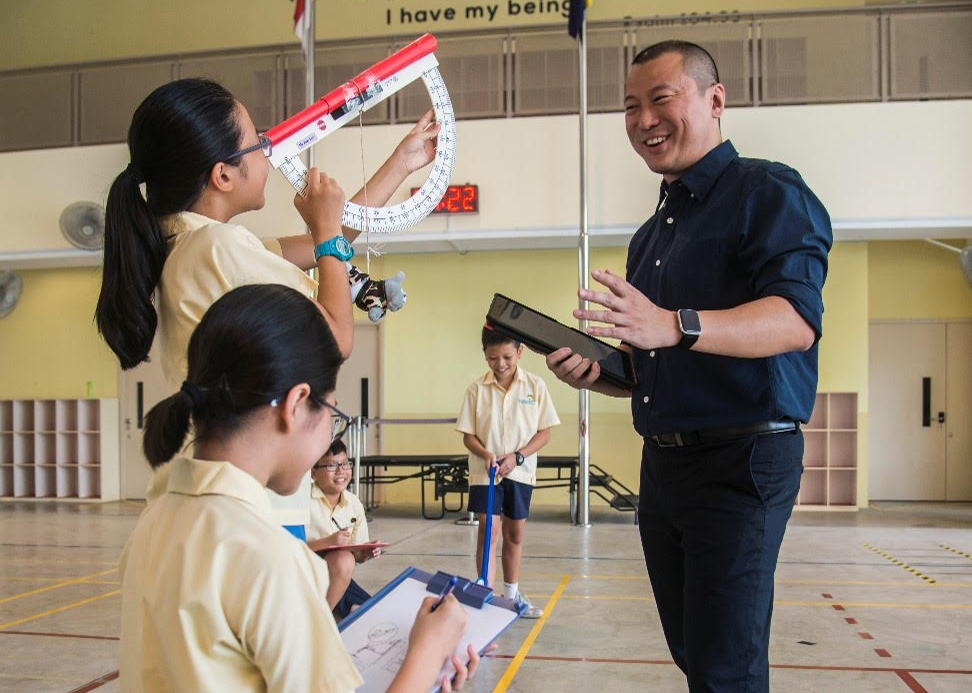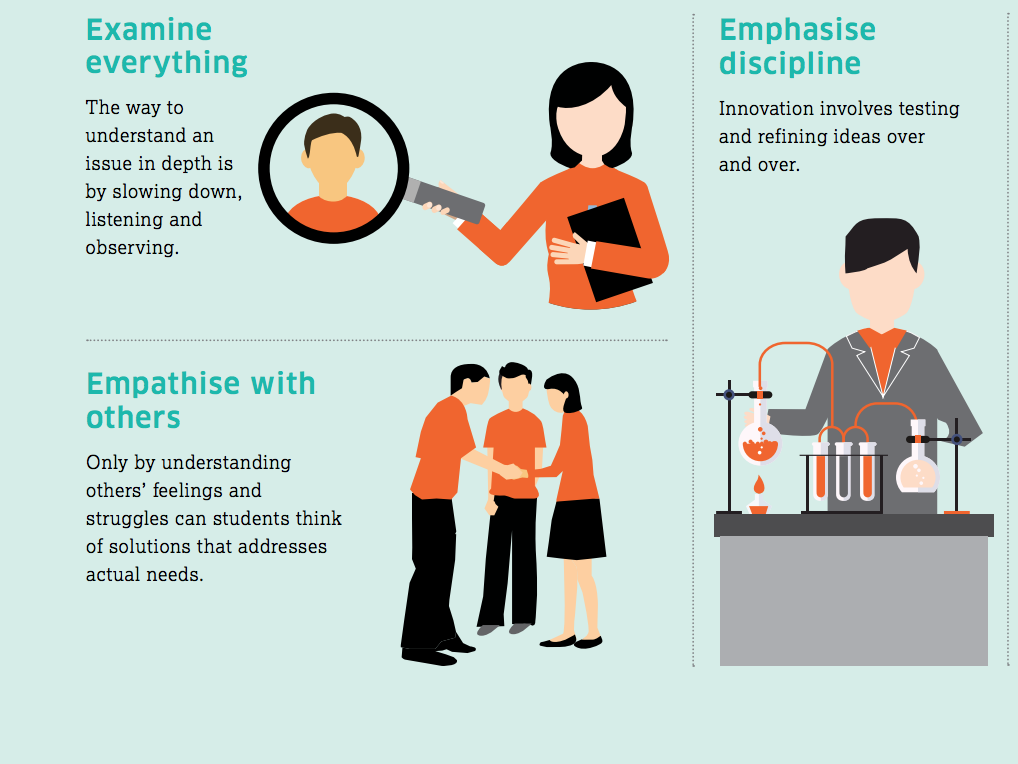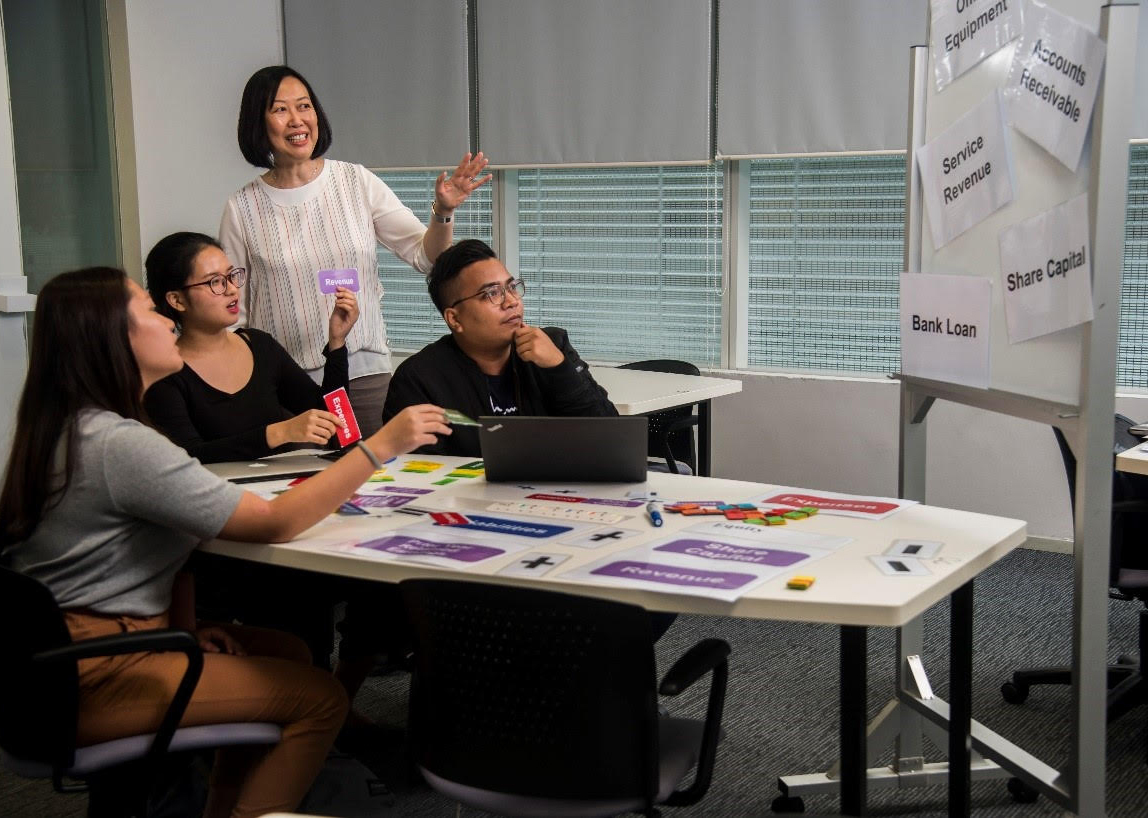Lim En-rui, Joel, Fairfield Methodist School (Primary), President’s Award for Teachers 2019 Recipient
The Primary 5 students of Fairfield Methodist School (Primary) have been given a task— — they need to measure the height of a flagpole – in the assembly area. Their tools? A protractor, a bubble tea straw, a tape measure and a trundle wheel to measure distance on the ground. Oh, and a teddy bear.
This is how Joel Lim, Lead Teacher (Mathematics) at Fairfield Methodist School (Primary), makes geometry fun and engaging.
To estimate the height of a flagpole, the students first construct a makeshift clinometer, a tool used to measure the angle of elevation or slope. They attach the straw to the straight edge of the protractor and hang the soft toy from the centre of the protractor. The straw enables them to direct their gaze to the top of the flagpole while the teddy bear hangs straight down and acts as a plumb bob so they can determine the angle of the straw relative to the ground.
Joel does not explain to the students how to go about using the clinometer to get the height of the flagpole. Instead, he gets the groups in the class to discuss how to do it after they’ve studied the properties of different triangles. (Hint: Estimating the height involves viewing the flagpole from a 45-degree angle.)
One important part of the lesson is being outside the classroom to figure out the heights of tall objects like flagpoles and basketball hoops. “The whole idea of problem solving outside the classroom is to make Mathematics come alive,” says Joel, a 13-year veteran of the teaching profession. “This encourages them to make use of what they learn in class in the world outside.”
However, the discussions that take place before the students are sent outside are also vital. Joel wants all the students to be involved in uncovering the solution. And to do so, he makes sure that no answers are shot down. “No answer is a bad answer,” he says. “The moment you try, I will take it and embrace it.” Everything that comes out of a student is important, he believes.
Discourse is critical to learning
He provides a psychologically safe learning environment so that the students are not afraid to fail and gives them an incentive to contribute to the discourse. That discourse, he says, is vital to learning. “If you have very strong discourse, you don’t have to write anything down,” says Joel, who has been a Lead Teacher for three years.
A good teacher, he says, will explain a concept. A very good teacher can explain that concept clearly. But a truly excellent teacher will guide learners to discover the concept for themselves. That is when the knowledge truly sinks in.
Joel’s job is to facilitate the students to get to the “aha” moment, he says. “That’s when it shifts from a very good lesson to an amazing lesson. That meaning-making, that sense of achievement is so strong, it’s etched into them. I want them to achieve joy.”
At the heart of his pedagogical approach is inquiry-based learning and problem-based learning. With inquiry-based learning, students are encouraged to explore materials, ask questions and share ideas. With problem-based learning, students learn through solving an open-ended problem. The exercise to find the height of the flagpole is an example that combines both pedagogies. Trying to determine the height of tall objects is a problem that they have to solve and students learn basic principles of Mathematics by trying to solve this problem. Along the way, students are encouraged to ask questions, to experiment and learn by trial and error and have productive failures.
Puzzles to hook students
All these approaches are pointless, however, if students are resistant. That is why Joel thinks that “sparking joy is the most important way to reach kids”.
To spark joy, Joel will use all kinds of tools: stories, puzzles, toys and scenarios. He is an avid board game player and collector and that inspires him to create puzzles to engage students. He devises escape rooms that have Maths puzzles to be solved. He also gets his students to work on Maths puzzles weekly. At the start of the week, Maths puzzles are given out, and at the end of the week, the class discusses the solutions presented. Joel then gives out prizes for effort and ingenuity. These puzzles do not test questions in the syllabus but test creativity and logical thinking. One question, for example, requires students to add in the right operators in the following sequence:
1 _ 1_ 1 = 6
2 _ 2 _ 2 = 6
3 _ 3 _ 3 = 6
all the way to
9 _ 9 _ 9 = 6
He takes students out of the classroom so they can look at nature and architecture to learn about the Golden Ratio and the Fibonacci Sequence. In the classroom, he uses high-tech toys like mini quadcopters to promote higher order thinking (What is the mass of a drone? What is the mass of the drone as it hovers?) However, not everything has to be high-tech: M&Ms are used to teach ratio while plasticine cakes demonstrate fractions at work.
Finding the balance between being too easy and too difficult
Getting the students hooked is the first step. The next challenge is to motivate them, which involves calibrating the lessons carefully. “Students don’t learn if they are given something that is too difficult,” he notes. “But they also don’t learn if they are not challenged enough.”
He creates opportunities for early success that builds up their confidence and then he ramps up the difficulty level. Not building up confidence is the reason a lot of students end up fearing Maths.
In addition, he welcomes failure. “I want the students to try. It’s better to try and find out it doesn’t work than to treat failure as bad.” The end goal is not to be satisfied with failure though, but to use it as a stepping stone to success.
For Joel, these principles aren’t merely to help the students master Mathematics; it’s to help them with their lives.
“The goal is not covering the curriculum. This is a vehicle to teach them more important things – to enjoy learning and to persevere despite roadblocks.”
“I use Mathematics as a vehicle to help them believe in themselves,” says Joel. “If I just go in to help them prepare for an exam, I feel I’m losing a great part of their potential.”






